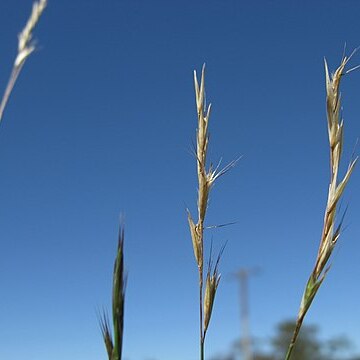Variable in size and habit from short, loose, slender, to large, stout, wiry tufts, bright green, ± shortly rhizomatous; leaves ≤ culms; branching extravaginal. Leaf-sheath light brown, glabrous or with ± stiff, scattered hairs; apical tuft of hairs to 3-(4) mm. Ligule 0.2-0.5 mm. Leaf-blade to 25 cm, ± flat, to 2 mm wide, or narrow and rolled, scattered or abundant, ± stiff hairs, or glabrous, margins closely scabrid. Culm to 90 cm, internodes smooth or minutely scabrid below inflorescence. Panicle to 15 cm, erect, racemose with few short branches below. Spikelets few to many on short pedicels; rachis uniformly short-scabrid, pedicels often bare below spikelets or with slightly longer hairs. Spikelets 5-10-flowered, awns, and sometimes upper florets, exserted from glumes. Glumes light green, margins purple above, 8-12 mm, lanceolate, subacute, ± equal; lower (5)-7-nerved, upper 5-(7)-nerved, sometimes a few scattered hairs. Lemma 2.5-3.5 mm, 9-nerved, upper row of hairs ≤ lemma, in large marginal and adjacent tufts with usually two, sometimes more or occasionally 0 central tufts, lower row of hairs continuous, reaching upper hairs, elsewhere glabrous or a few scattered hairs, obviously narrowed and prominently nerved above callus; lobes 5-10 mm, abruptly narrowed to awns; central awn 11-14 mm, column (1.5)-2-3-(4) mm. Palea 3.5-5 mm, = upper marginal tufts, interkeel and margins glabrous. Callus very narrow, (0.6)-0.9-1.5 mm, marginal hair tufts short, usually < lower lemma hairs. Rachilla minute, 0.1-0.2 mm. Anthers 0.3-1.2 and 1.4-2.0 mm. Caryopsis 1.7-2.1 × 0.8-1.1 mm; embryo 0.8-0.9 mm; hilum 0.4-0.5 mm.
More
Plants loosely caespitose; innovation buds extravaginal. Culms 16–60 cm high. Inflorescences linear or very rarely obliquely ovate, almost a spike, with few basal branches. Spikelets 7.5–15 mm long, with 4–10 florets; pedicels parallel to inflorescence axis. Glumes shorter than to equalling florets; lower glume 6.3–12.3 mm long, c. 2.5 mm wide. Callus hairs not reaching lower lemma hairs. Lemma: body 2–3.5 mm long, glabrous between the rows of tufts; upper row of hair tufts of marginal and some dorsal tufts, rarely complete, rarely of only marginal tufts; lower row of tufts complete, not reaching or equalling upper row; lobes as long as body, often with a small apical lobule; setae 0–3.5 mm long, shorter than or as long as lobes; awn 6–14.5 mm long, exceeding setae; awn column tightly twisted, shorter than or equalling lobes. Palea linear to lorate, 3–4.8 mm long, narrow, 3–5 times as long as wide, much exceeding lemma sinus. Anthers 0.4–2.3 mm long. Caryopsis 1.6–2 mm long.
Common in disturbed habitats, where it can be locally common, usually inlightly shaded habitats, often found under trees, occasionally in full sun.

